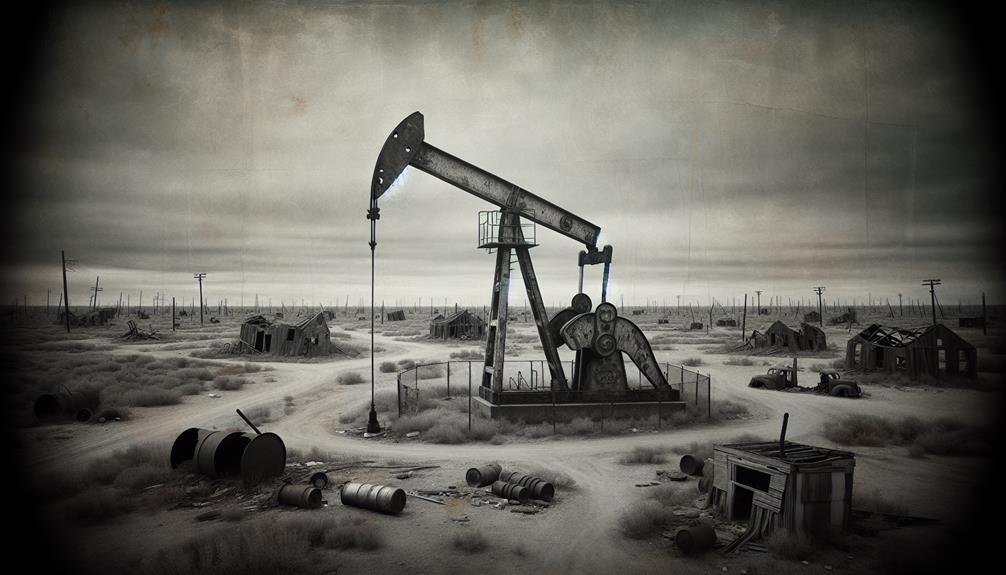When remnants of oil towns in America are preserved, it honors their pivotal role in history. These sites echo a bygone era, marking the growth of industrial might, economic shifts, and diverse communities. Retaining them highlights their architectural charm and cultural significance, serving as reminders of past resilience and innovation. The efforts to safeguard these remnants showcase a commitment to preserving heritage and fostering understanding. Their existence allows you to glimpse into the vibrant past, appreciating the layers of stories woven into the fabric of American development. Uncover the rich tapestry of history and culture waiting to be explored further.
Key Points
- Showcasing historical significance and cultural heritage
- Mitigating environmental impacts through preservation efforts
- Preserving architectural innovation and community identity
- Valuable tourism and educational opportunities for visitors
- Contributing to the overall well-being of the environment and society
Historical Significance of Oil Towns
The historical significance of oil towns lies in their pivotal role in fueling the industrial revolution and shaping the economic landscape of America. These towns emerged as key players in the extraction and refinement of oil, leading to rapid industrialization and urbanization. The social implications were profound, as a surge in job opportunities attracted people from diverse backgrounds, fostering a melting pot of cultures within these communities.
However, this rapid growth came with environmental consequences. The extraction and processing of oil led to pollution and deforestation, impacting the natural habitats surrounding these towns. The environmental degradation caused by oil activities raised concerns about sustainability and the long-term effects on both the environment and human health.
Despite the social and environmental challenges, oil towns played a vital role in propelling America into an era of industrial dominance. Understanding the historical significance of these towns provides insight into the complex interplay between industrial progress, social dynamics, and environmental stewardship.
Economic Impact on Local Communities
Examining the economic impact of oil towns on local communities reveals a complex web of financial interdependence and socio-economic dynamics. Oil towns often play a significant role in community development by creating job opportunities and fostering economic growth. The presence of oil industries in these towns leads to job creation across various sectors, from drilling and extraction to transportation and hospitality. As a result, local residents benefit from increased employment options and a higher influx of income into the community.
Moreover, the economic activities generated by oil towns contribute to the overall prosperity of the region. Businesses, both large and small, thrive due to the demand created by a growing population of workers and residents. This, in turn, leads to a cycle of economic development where increased job opportunities lead to higher income levels, improved living standards, and enhanced community infrastructure.
In essence, the economic impact of oil towns on local communities is profound, shaping the socio-economic landscape and fostering growth and prosperity through job creation and community development.
Preservation Efforts and Initiatives
Preserved remnants of oil towns in America showcase the historical significance and cultural heritage of these once-thriving communities. Community engagement plays an essential role in the preservation efforts of these towns. Local residents, historians, and preservationists collaborate to guarantee that the unique history and stories of these places aren't lost to time. By involving the community in these initiatives, a sense of pride and ownership is fostered, leading to greater support for the preservation projects.
Environmental concerns also factor into the preservation efforts of oil towns. Many of these sites have been impacted by industrial activities, posing risks to the surrounding ecosystems. Preservation initiatives often include measures to mitigate these environmental impacts, such as soil remediation and habitat restoration. By addressing these concerns, the preservation of oil towns not only protects their historical value but also contributes to the overall well-being of the environment.
Through a combination of community engagement and environmental conservation, these remnants of oil towns can continue to stand as proofs to America's industrial past.
Cultural and Architectural Heritage
Amidst the remnants of oil towns in America, a trove of cultural and architectural heritage awaits exploration and appreciation. These towns bear witness to a unique blend of architectural innovation and community identity that emerged during the oil boom era. The buildings, from grand mansions to humble worker housing, showcase the rapid growth and diverse influences that shaped these communities.
Architectural innovation in oil towns is evident in the eclectic mix of styles, ranging from Victorian and Craftsman to Art Deco and Mid-Century Modern. Each building tells a story of the aspirations and lifestyles of the people who inhabited these spaces. The preservation of these structures offers a window into the past, allowing visitors to experience a tangible connection to history.
Furthermore, the architecture of oil towns reflects the community identity that was forged through shared experiences and challenges. The churches, schools, theaters, and town halls stand as symbols of unity and resilience in the face of economic booms and busts. By exploring these architectural remnants, one can gain a deeper appreciation for the cultural heritage that continues to shape American society today.
Tourism and Education Opportunities
Exploring the remnants of oil towns in America presents valuable tourism and educational opportunities for those interested in delving into the rich history and architectural significance of these unique communities. Sustainable development initiatives have transformed many of these towns into living museums, offering visitors a chance to witness firsthand the evolution of these once-booming centers. Engaging with these preserved remnants fosters community engagement, as locals often play a pivotal role in guiding tours, sharing personal stories, and showcasing the cultural heritage of their town.
Educational programs tailored to these sites provide experiential learning opportunities for students and history enthusiasts alike. By immersing oneself in the physical remnants of oil towns, individuals can gain a deeper understanding of the challenges and successes that shaped these communities. These interactive experiences offer a tangible connection to the past, allowing participants to appreciate the resilience of the people who once called these towns home.
Frequently Asked Questions
How Do Oil Towns Compare to Other Types of Industrial Towns in Terms of Preservation Efforts?
When comparing oil town preservation efforts to other industrial towns, consider the unique blend of historical significance and economic impact. Understanding these dynamics can shed light on why remnants of oil towns are often prioritized for preservation over other industrial sites.
Are There Any Unique Challenges Faced in Preserving Oil Towns Compared to Other Historical Sites?
Preserving oil towns poses unique challenges due to environmental impact, economic shifts, and community ties. Conservation efforts require balancing historical significance with modern needs, making it essential to navigate preservation strategies that honor both past and present.
What Role Do Environmental Factors Play in the Preservation of Oil Towns?
Environmental impact on oil town preservation is significant. Natural disasters, pollution, and climate change threaten these sites. Community engagement fosters awareness and protective measures. Balancing environmental concerns with historical preservation is essential for sustainability.
How Do Oil Towns Contribute to the Overall Narrative of American Industrial History?
Oil towns play a pivotal role in American industrial history by showcasing the evolution of labor dynamics and technological advancements. They provide a tangible link to the past, highlighting the impact of industrialization on society.
Are There Any Specific Regulations or Guidelines in Place for the Preservation of Oil Towns?
Preservation guidelines for oil towns vary, reflecting their historical significance. Conservation efforts often involve community engagement. Specific regulations aim to protect these sites, maintaining an essential part of American industrial history for future generations.



